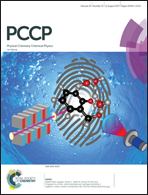Transport of water molecules through noncylindrical pores in multilayer nanoporous graphene
Abstract
In this study, molecular dynamics (MD) simulations are used to examine the water transport properties through asymmetric hourglass-shaped pores in multilayer nanoporous graphene with a constant interlayer separation of 6 Å. The properties of the tested asymmetric hourglass-shaped pores [with the models having long cone (l1, −P) and short cone (l2, +P) entrances] are compared to a symmetric pore model. The study findings indicate that the water occupancy increases across the asymmetric pore (l1, −P) compared to (l2, +P), because of the length effect. The asymmetric pore, (l1, −P), yields higher flux compared to (l2, +P) and even the symmetric model, which can be attributed to the increase in the hydrogen bonds. In addition, the single-file water molecules across the narrowest pore diameter inside the (l2, +P) pore exhibit higher viscosity compared to those in the (l1, −P) pore because of the increase in the water layering effect. Moreover, it is found that the permeability inside the multilayer hourglass-shaped pore depends on the length of the flow path of the water molecules before approaching the layer with the smallest pore diameter. The probability of dipole orientation exhibits wider distribution inside the (l1, −P) system compared to (l2, +P), implying an enhanced formation of hydrogen bonding of water molecules. This results in the fast flow of water molecules. The MD trajectory shows that the dipole orientation across the single-layer graphene has frequently flipped compared to the dipole orientation across the pores in multilayer graphene, which is maintained during the whole simulation time (although the dipole orientation has flipped for a few picoseconds at the beginning of the simulation). This can be attributed to the energy barrier induced by the individual layer. The diffusion coefficient of water molecules inside the (l2, +P) system increases with pressure difference, however, it decreases inside the (l1, −P) system because of the increase in the number of collisions. It was found that the velocity in the axial direction (z-direction) has a significant impact on the permeation ability of water molecules across the asymmetric nanopores examined in this study. Finally, the study results suggest that the appropriate design of an asymmetric hourglass-shaped nanopore in multilayer graphene can significantly improve the water permeation rate even compared to a symmetric structure.



 Please wait while we load your content...
Please wait while we load your content...